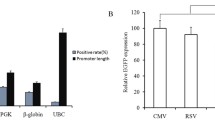Abstract
A runaway vector for mammalian cells was constructed from the simian virus 40 (SV40) genome with a temperature-sensitive mutation of the large T antigen and bacterial neo r gene. Replication of this plasmid was repressed above 39°C and vigorous DNA propagation was observed below 33°C in simian CV-1 cells. The human erythropoietin gene was inserted downstream of the SV40 late promoter of the plasmid and the recombinant plasmid was introduced into CV-1 cells. By a temperature shift from 37 to 33°C, the plasmid copy number increased from 5 × 102 to 5 × 103 copies per cell and the specific production rate of erythropoietin increased more than ten-fold. The bacterial-derived sequences such as the neo r gene and vector pUC sequences were prone to delete but the main body of the recombinant plasmid such as SV40 and the erythropoietin-coding sequences were stably maintained at either 33 or 37°C.
Similar content being viewed by others
References
Acheson NH (1979) Lytic cycle of SV40 and polyoma virus. In: Tooze J (ed) The molecular biology of tumor viruses, 2nd ed. Cold Spring Harbor Laboratory, Cold Spring Harbor, N.Y., pp 125–204
Chirgwin JM, Przybyla AE, MacDonald RJ, Rutter WJ (1979) Isolation of biologically active ribonucleic acid from sources enriched in ribonuclease. Biochemistry 18:5294–5299
Chittenden T, Frey R, Levine AJ (1991) Regulated replication of an episomal simian virus 40 origin plasmid in COS7 cells. J Virol 65:5944–5951
Crouse GF, McEvan RN, Pearson ML (1983) Expression and amplification of engineered mouse dihydrofolate reductase minigenes. Mol Cell Biol 3:257–266
Feinberg AP, Vogelstein B (1983) A technique for radiolabeling DNA restriction endonuclease fragments to high specific activity. Anal Biochem 132:6–13
Gerard RD, Glutzman Y (1985) New host cell system for regulated simian virus 40 DNA replication. Mol Cell Biol 5:3231–3240
Gluzman Y (1981) SV40-transformed simian cells support the replication of early SV40 mutants. Cell 23:175–182
Graham F, van der Eb AJ (1973) A new technique for the assay of infectivity of human adenovirus 5 DNA. Virology 52:456–457
Hirt B (1967) Selective extraction of polyoma DNA from infected mouse cell cultures. J Mol Biol 26:365–369
Jacobs K, Shoemaker C, Rudersdorf R, Neill SD, Kaufman RJ, Mufson A, Seehra J, Simon S, Jones S, Hewick R, Fritsch EF, Kawakita M, Shimizu T, Miyake T (1985) Isolation and characterization of genomic and cDNA clones of human erythropoietin. Nature 313:806–810
Kawamura A, Imai N, Kawaguchi T, Hayakawa T (1991) Simple in vivo bioassay for erythropoietin. Br J Haematol 77:424–430
Khoury G, Lai CJ (1979) Preparation of simian virus 40 and its DNA. Methods Enzymol 8:404–412
Kimura G, Dulbecco R (1973) A temperature-sensitive mutant of simian virus 40 affecting transforming ability. Virology 52:529–534
Law MF, Dowy DR, Dvoretsky I, Howley PM (1981) Mouse cells transformed by bovine papilloma virus contain only extrachromosomal viral DNA sequences. Proc Natl Acad Sci USA 78:2727–2731
Lupton S, Levine A (1985) Mapping genetic elements of Epstein-Barr virus-that facilitate extrachromosomal persistence of Epstein-Barr virus-derived plasmids in human cells. Mol Cell Biol 5:2533–2542
Lusky M, Botchan M (1981) Inhibition of SV40 replication in simian cells by specific pBR322 DNA sequences. Nature 293:79–81
Maniatis T, Fritsch EF, Sambrook J (1982) Molecular cloning, a laboratory manual. Cold Spring Harbor Laboratory, Cold Spring Harbor, N.Y.
Powell JS, Berkner KL, Lebo RV, Adamson JW (1986) Human erythropoietin gene: High level expression in stably transformed mammalian cells and chromosome localization. Proc Natl Acad Sci USA 83:6465–6469
Rio DC, Clark SG, Tjian R (1985) A mammalian host vector system that regulates expression and amplification of transfected genes by temperature induction. Science 227:23–28
Roberts JM, Weintraub H (1988) Cis-acting negative control of DNA replication in eukaryotic cells. Cell 52:397–404
Shirai Y, Sasaki R, Hashimoto K, Kawahara H, Hitomi H, Chiba H (1988) Continuous production of erythropoietin with immobilized animal cells. Appl Microbiol Biotechnol 29:544–549
Southern EM (1975) Detection of specific sequences among DNA fragments separated by gel electrophoresis. J Mol Biol 98:503–517
Thomas KR, Capecchi MR (1987) Site-directed mutagenesis by gene targeting in mouse embryo-derived stem cells. Cell 51:503–512
Tsui L-C, Breitman ML (1985) Replication of pSV2-gpt in COS-1 cells: stability of plasmid DNA in the presence and absence of biochemical selection. Somatic Cell Mol Genet 11:167–176
Author information
Authors and Affiliations
Rights and permissions
About this article
Cite this article
Kirinaka, H., Kamihira, M., Iijima, S. et al. A new runaway type episomal vector for mammalian cells based on a temperature-sensitive simian virus 40 and inducible erythropoietin production. Appl Microbiol Biotechnol 41, 591–596 (1994). https://doi.org/10.1007/BF00178495
Received:
Revised:
Accepted:
Issue Date:
DOI: https://doi.org/10.1007/BF00178495




